Related Research Articles

A nursery rhyme is a traditional poem or song for children in Britain and other European countries, but usage of the term dates only from the late 18th/early 19th century. The term Mother Goose rhymes is interchangeable with nursery rhymes.

Humpty Dumpty is a character in an English nursery rhyme, probably originally a riddle and one of the best known in the English-speaking world. He is typically portrayed as an anthropomorphic egg, though he is not explicitly described as such. The first recorded versions of the rhyme date from late eighteenth-century England and the tune from 1870 in James William Elliott's National Nursery Rhymes and Nursery Songs. Its origins are obscure, and several theories have been advanced to suggest original meanings.

Mother Goose is a character that originated in children's fiction, as the imaginary author of a collection of French fairy tales and later of English nursery rhymes. She also appeared in a song, the first stanza of which often functions now as a nursery rhyme. The character also appears in a pantomime tracing its roots to 1806.

"Lavender's Blue" is an English folk song and nursery rhyme from the 17th century. Its Roud Folk Song Index number is 3483. It has been recorded in various forms and some pop versions have been hits in the U.S. and U.K. charts.
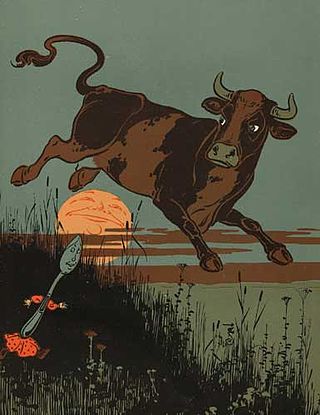
"Hey Diddle Diddle" is an English nursery rhyme. It has a Roud Folk Song Index number of 19478.
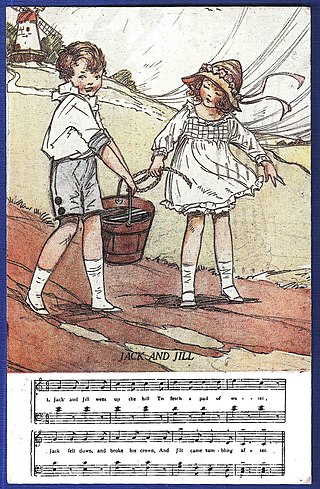
"Jack and Jill" is a traditional English nursery rhyme. The Roud Folk Song Index classifies the commonest tune and its variations as number 10266, although it has been set to several others. The original rhyme dates back to the 18th century and different numbers of verses were later added, each with variations in the wording. Throughout the 19th century new versions of the story were written featuring different incidents. A number of theories continue to be advanced to explain the rhyme's historical origin.

"The Man in the Moon Stayed Up Too Late" is J. R. R. Tolkien's imagined original song behind the nursery rhyme "Hey Diddle Diddle ", invented by back-formation. It was first published in Yorkshire Poetry magazine in 1923, and was reused in extended form in the 1954–55 The Lord of the Rings as a song sung by Frodo Baggins in the Prancing Pony inn. The extended version was republished in the 1962 collection The Adventures of Tom Bombadil.

"Rub-a-dub-dub" is an English language nursery rhyme first published at the end of the 18th century in volume two of Hook's Christmas Box under the title "Dub a dub dub" rather than "Rub a dub dub". It has a Roud Folk Song Index number of 3101.

"Ring a Ring o' Roses", "Ring a Ring o' Rosie", or "Ring Around the Rosie", is a nursery rhyme, folk song and playground singing game. Descriptions first emerge in the mid-19th century, but are reported as dating from decades before, and similar rhymes are known from across Europe, with various lyrics. It has a Roud Folk Song Index number of 7925.
A children's song may be a nursery rhyme set to music, a song that children invent and share among themselves or a modern creation intended for entertainment, use in the home or education. Although children's songs have been recorded and studied in some cultures more than others, they appear to be universal in human society.

"One, Two, Buckle My Shoe" is a popular English language nursery rhyme and counting-out rhyme of which there are early occurrences in the US and UK. It has a Roud Folk Song Index number of 11284.

"Pease Porridge Hot" or "Pease Pudding Hot" is an English children's singing game and nursery rhyme. It has a Roud Folk Song Index number of 19631.
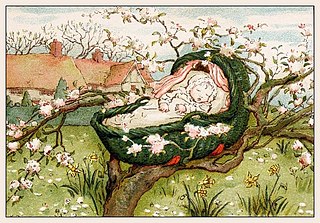
"Rock-a-bye baby on the tree top" is a nursery rhyme and lullaby. It has a Roud Folk Song Index number of 2768.

"There Was an Old Woman Who Lived in a Shoe" is a popular English language nursery rhyme, with a Roud Folk Song Index number of 19132. Debates over its meaning and origin have largely centered on attempts to match the old woman with historical female figures who have had large families, although King George II (1683–1760) has also been proposed as the rhyme's subject.
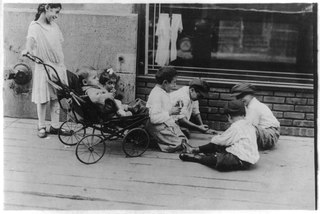
Childlore is the folklore or folk culture of children and young people. It includes, for example, rhymes and games played in the school playground. The best known researchers of the field were Iona and Peter Opie.
"Taffy was a Welshman" is an English language nursery rhyme which was popular between the eighteenth and twentieth centuries. It has a Roud Folk Song Index number of 19237.

‘Little Robin Redbreast’ is an English language nursery rhyme, chiefly notable as evidence of the way traditional rhymes are changed and edited. It has a Roud Folk Song Index number of 20612.
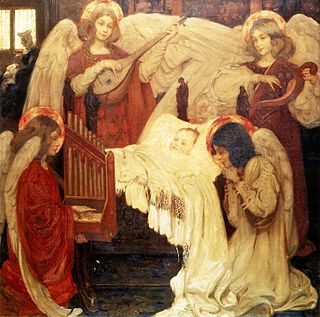
"Matthew, Mark, Luke and John", also known as the "Black Paternoster", is an English children's bedtime prayer and nursery rhyme. It has a Roud Folk Song Index number of 1704. It may have origins in ancient Babylonian prayers and was being used in a Christian version in late Medieval Germany. The earliest extant version in English can be traced to the mid-sixteenth century. It was mentioned by English Protestant writers as a "popish" or magical charm. It is related to other prayers, including a "Green" and "White Paternoster", which can be traced to late Medieval England and with which it is often confused. It has been the inspiration for a number of literary works by figures including Henry Wadsworth Longfellow and musical works by figures such as Gustav Holst. It has been the subject of alternative versions and satires.

Gammer Gurton's Garland: or, The Nursery Parnassus, edited by the literary antiquary Joseph Ritson, is one of the earliest collections of English nursery rhymes. It was first published as a chapbook in 1784, but was three times reprinted in expanded editions during the following century, as were several unrelated children's books with similar titles. Gammer Gurton's Garland put into print for the first time some of our best-known nursery rhymes.

"Diddle Diddle Dumpling" is the fifth episode of the third series of the British black comedy anthology television series Inside No. 9. It was written by Steve Pemberton and Reece Shearsmith, and first aired on 14 March 2017, on BBC Two. The episode, which was directed by Guillem Morales, follows the story of David, played by Shearsmith, a middle class stay-at-home dad, who happens across a lone black shoe. Much to the concern of his wife Louise, played by Keeley Hawes, he becomes obsessed with finding the shoe's owner. The episode follows the development of his obsession. Rosa Strudwick plays Sally, David and Louise's daughter, and Pemberton plays Chris, a family friend. Danny Baker voices a radio presenter, and Mathew Baynton also appears.
References
- 1 2 I. Opie and P. Opie (1951). The Oxford Dictionary of Nursery Rhymes (1st ed.). Oxford: Oxford University Press. pp. 245–6. (2nd ed. 1997)
- ↑ Wright, The Original Mother Goose (1916), as quoted on mothergooseclub.com
- ↑ Smith, The Little Mother Goose (1912), as quoted on mothergooseclub.com
- BBC 'Inside number 9' TV episode with the same name
- Sky's British black comedy 'Hunderby', set in the 1830s, features the song as evening entertainment accompanied by a traditional crumhorn.